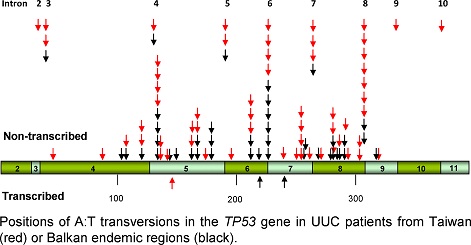Aristolochia-Based Herbal Medicines and Urothelial Cancer
Grollman, Dickman, Sidorenko, Chen and Pu
 Aristolochia plants have been used worldwide for medicinal purposes for more than 2500 years, and this practice is still common in many cultures today, particularly in Asia. In Taiwan, where the incidence of upper urinary tract urothelial carcinoma (UUC) and of chronic kidney disease is the highest in the world, at least one-third of the population has been prescribed herbs containing aristolochic acid (AA). This prompted us to determine if ingestion of Aristolochia-based traditional medicines contributes significantly to the high frequency of kidney disease and UUC in Taiwan, representing an under-reported, but widespread, iatrogenic disease. Remarkably, the unique TP53 mutational signature for AA established in our studies of UUC cases associated with Balkan Endemic Nephropathy was recapitulated in a series of UUC cases from Taiwan. DNA adducts formed with AA metabolites were detected in the majority of patients with signature A:T transversion mutations in TP53, indicating a strong connection between AA exposure and its carcinogenic effect. Thus, despite different modes of exposure (in Balkan cases, chronic low-dose dietary exposure, and in Taiwan, higher amounts of AA ingested intermittently for medicinal purposes), both the pathophysiology and molecular biomarkers of UUC are similar.
Aristolochia plants have been used worldwide for medicinal purposes for more than 2500 years, and this practice is still common in many cultures today, particularly in Asia. In Taiwan, where the incidence of upper urinary tract urothelial carcinoma (UUC) and of chronic kidney disease is the highest in the world, at least one-third of the population has been prescribed herbs containing aristolochic acid (AA). This prompted us to determine if ingestion of Aristolochia-based traditional medicines contributes significantly to the high frequency of kidney disease and UUC in Taiwan, representing an under-reported, but widespread, iatrogenic disease. Remarkably, the unique TP53 mutational signature for AA established in our studies of UUC cases associated with Balkan Endemic Nephropathy was recapitulated in a series of UUC cases from Taiwan. DNA adducts formed with AA metabolites were detected in the majority of patients with signature A:T transversion mutations in TP53, indicating a strong connection between AA exposure and its carcinogenic effect. Thus, despite different modes of exposure (in Balkan cases, chronic low-dose dietary exposure, and in Taiwan, higher amounts of AA ingested intermittently for medicinal purposes), both the pathophysiology and molecular biomarkers of UUC are similar.
It is estimated that 100 million people in China alone have taken Aristolochia herbal remedies, highlighting the potential morbidity and mortality associated with the medicinal use of these herbs. Thus, an important goal of our current research is to document exposure to AA and its relationship to kidney disease and UUC in countries where Aristolochia is known to be used in the practice of Traditional Chinese Medicine, These studies are underway in collaboration with urologists and nephrologists in China and other Asian countries. A second goal is to develop and validate biomarkers, detectable in urine or blood, that can be effectively used for diagnostic surveillance. The mutagenic DNA adducts caused by AA persist for decades in target tissues, thus populations at risk of UUC should be screened for evidence of this disease, as early diagnosis increases significantly the chances of a surgical cure.
- Springer S, Chen C-H, Grollman A P, Turesky R J, Yun B H, Rosenquist T A, Pu Y-S, Kinzler K W, Vogelstein B, DickmanK G, Netto G J. Non-invasive detection of urothelial cancer through the analysis of driver gene mutations and aneuploidy. eLife, 2018. PMID29557778
- Grollman A.P., Marcus D.M. Global hazards of herbal remedies: lessons from Aristolochia. EMBO 17(5):619-625, 2016. PMID27113747
- Marcus D.M., Grollman A.P.Toxicity of Botanical Medicines: An Overlooked Global Health Problem. AM J Public Health 106(1):16-7, 2016. PMID26562106
- Grollman A.P. Aristolochic Acid-Induced Urothelial Carcinoma: A Preventable Global Disease Proceedings, 44th Intl Symposium of the Princess Takamatsu Cancer Research Fund, 2013.
- Hoang M.L., Chen C-H., Sidorenko V.S., He J., Dickman K.G., Yun B.H., Moriya M., Niknafs N., Douville C., Karchin R., Turesky R.J., Pu Y-S., Vogelstein B., Papadopoulos N., Grollman A.P., Kinzler K.W., Rosenquist T.A. Mutational Signature of Aristolochic Acid Exposure as Revealed by Whole Exome Sequencing. Sci Transl Med 5(197):197ra102, 2013. PMID23926200
- Grollman A.P. Aristolochic acid nephropathy: Harbinger of a global iatrogenic disease. Environmental and Molecular Mutagenesis 54(1):1-7, 2013. PMID23238808
- Chen CH, Dickman KG, Moriya M, Zavadil J, Sidorenko VS, Edwards KL, Gnatenko DV, Wu L, Turesky RJ, Wu XR, Pu YS, and Grollman AP. Aristolochic acid-associated urothelial cancer in Taiwan. Proc Natl Acad Sci USA 109:8241-6, 2012. PMID22493262
- Grollman AP, Scarborough J, and Jelakovic B. Aristolochic Acid Nephropathy: An Environmental and Iatrogenic Disease, in Advances in Molecular Toxicology 3, J Fishbein, Ed., Elsevier:Amsterdam, 2009.

